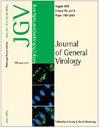在雪貂模型中,SARS-CoV-2 通过皮肤至口鼻途径感染和传播,并产生生物气溶胶
IF 3.6
4区 医学
Q2 BIOTECHNOLOGY & APPLIED MICROBIOLOGY
引用次数: 0
摘要
严重急性呼吸系统综合症冠状病毒 2(SARS-CoV-2)的直接和间接传播归因于病毒在飞沫、生物气溶胶以及包括皮肤和物体表面在内的体表上的存活。在猪皮肤上评估了 SARS-CoV-2 变异株(Alpha、Beta、Gamma 和 Delta)在皮肤上的存活情况,以及皮肤与皮肤接触后病毒的传播情况。在生物相关温度(35.2 °C)下 72 h 后,通过 RT-qPCR 在皮肤上检测到 SARS-CoV-2 变体,在连续十次皮肤接触后检测到病毒 RNA (vRNA)。此外,还研究了皮肤对皮肤的病毒传播,从而在雪貂间建立感染模型,作为鼬科动物和人类轻度/无症状 SARS-CoV-2 感染的模型,并与雪貂腔内接种进行了比较。将 Delta 变异型 SARS-CoV-2 以湿接种或干接种的形式接种到猪皮肤上的雪貂(Naïve ferrets)在接触后长达 14 天内都能检测到脱落,病毒载量与鼻内接种的雪貂相当。在与受感染雪貂的直接接触中,SARS-CoV-2 可传播给未感染的雪貂,从雪貂毛拭子和空气样本中可检测到环境污染。在雪貂经单次接触后获得的生物气溶胶样本中发现了基因替换,包括Spike、ORF1ab和ORF3a蛋白序列,这表明通过空气采样监测宿主适应性和病毒进化是有用的。SARS-CoV-2变体直接在皮肤上存活的时间较长,皮肤与皮肤之间的转移使得随后通过皮肤到口腔-鼻腔的接触途径感染成为可能,这代表了SARS-CoV-2感染的一种途径,对公共卫生和兽医健康产生了影响。本文章由计算机程序翻译,如有差异,请以英文原文为准。
SARS-CoV-2 infection and transmission via the skin to oro-nasal route with the production of bioaerosols in the ferret model
Direct and indirect transmission of severe acute respiratory syndrome coronavirus 2 (SARS-CoV-2) has been attributed to virus survival in droplets, bioaerosols and on fomites including skin and surfaces. Survival of SARS-CoV-2 variants of concern (Alpha, Beta, Gamma, and Delta) on the skin and virus transference following rounds of skin-to-skin contact were assessed on porcine skin as a surrogate for human skin. SARS-CoV-2 variants were detectable on skin by RT-qPCR after 72 h at biologically relevant temperatures (35.2 °C) with viral RNA (vRNA) detected after ten successive skin-to-skin contacts. Skin-to-skin virus transmission to establish infection in ferrets as a model for mild/asymptomatic SARS-CoV-2 infection in mustelids and humans was also investigated and compared to intranasal ferret inoculation. Naïve ferrets exposed to Delta variant SARS-CoV-2 in a ‘wet’ or ‘dry’ form on porcine skin resulted in robust infection with shedding detectable for up to 14 days post-exposure, at comparable viral loads to ferrets inoculated intranasally. Transmission of SARS-CoV-2 to naïve ferrets in direct contact with infected ferrets was achieved, with environmental contamination detected from ferret fur swabs and air samples. Genetic substitutions were identified in bioaerosol samples acquired following single contact passage in ferrets, including Spike, ORF1ab, and ORF3a protein sequences, suggesting a utility for monitoring host adaptation and virus evolution via air sampling. The longevity of SARS-CoV-2 variants survival directly on the skin and skin-to-skin transference, enabling subsequent infection via the skin to oro-nasal contact route, could represent a pathway for SARS-CoV-2 infection with implications to public and veterinary health.
求助全文
通过发布文献求助,成功后即可免费获取论文全文。
去求助
来源期刊

Journal of General Virology
医学-病毒学
CiteScore
7.70
自引率
2.60%
发文量
91
审稿时长
3 months
期刊介绍:
JOURNAL OF GENERAL VIROLOGY (JGV), a journal of the Society for General Microbiology (SGM), publishes high-calibre research papers with high production standards, giving the journal a worldwide reputation for excellence and attracting an eminent audience.
 求助内容:
求助内容: 应助结果提醒方式:
应助结果提醒方式:


